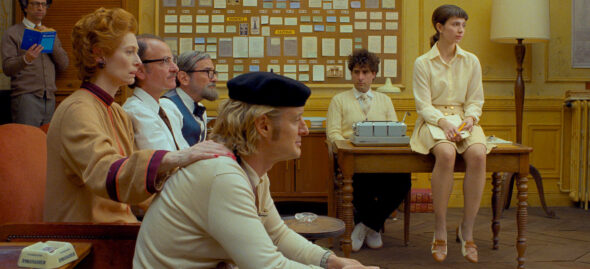
“The French Dispatch,” held over for a week at the Little Art Theatre, will screen on Friday, Nov. 12, and Monday, Nov. 15, at 7 p.m., Saturday, Nov. 13, at 2 and 7 p.m., and Sunday, Nov. 14, at 2 and 5 p.m.
Review | The tweedy pastiche of ‘The French Dispatch’
- Published: November 11, 2021
By now, we all know what to expect from a Wes Anderson film: whimsy abounds; cheeky dialogue, dripping with wit and clever repartee; cigarette-smoking characters whose artistry always comes at a cost; and picturesque stage-settings in which every star-studded frame could be a painting.
“The French Dispatch,” Anderson’s tenth feature film, delivers on all this in spades. It is, by my measure, the closest approximation to the director’s magnum opus — because all of these elements, among others, come into dazzling, pristine relief. His dioramic scenes are crafted with so much apparent intention and stagecraft — each bursting at the tweed seams with classic Anderson aesthetics in their fullest form.
But unlike his other films, we’re expected to read this one. It is, after all, both in form and reference, a love letter to The New Yorker and some of its past luminaries.
“The French Dispatch” pastiches a literary travelogue by the same name, the fictional French Dispatch. Headquartered in the ramshackle imaginary city of Ennui-sur-Blasé, France, the Dispatch is the international and cultural supplement to the also-fictional Liberty Kansas Evening Sun.
The story picks up in 1975, after a 50-year run of the Dispatch, and at the time of the magazine’s final publication and the impending death of its editor, Arthur Howitzer Jr. (Bill Murray). We find Howitzer and his team of mostly expat writers, artists, copy editors and various contributors assembling the last edition. Thus, the magazine becomes Anderson’s classic nesting doll — an all-too characteristic device of Anderson’s that allows him to bundle four stories into one.
The final edition begins with a playful sketch of the Parisian-esque Ennui by a writer and cyclist named Herbsaint Sazerac (Owen Wilson). As our guide, Sazerac pedals through Ennui’s cobblestone streets while narrating his final contribution to the magazine — a charming portrait of the city’s seedy underbelly. He highlights the gangs of violent altar boys who prey on the elderly and the 8.25 bodies per year that are fished out of the local river.
Then come the feature stories. The first is written by J.K.L. Berensen (Tilda Swinton), who tells the tale of the psychopathic artist Moses Rosenthaler (Benicio Del Toro). While incarcerated in a maximum security prison in Ennui, Rosenthaler falls in love with a prison guard — who also, to no fan of Anderson’s surprise, becomes Rosenthaler’s muse and propels him to international fame.
Next we hear from Lucinda Krementz (Frances McDormand), the Dispatch’s political correspondent, who details a student rebellion in Ennui. The movement, led by the moody revolutionary Zeffirelli B. (Timothée Chalamet), centers around the simple call-to-action that male students be allowed into the women’s dormitories. Naturally, the cause is propped up by rough-hewn political ideals and a ferocity matched only by the students’ naïveté.
In the final feature installment, the Black, gay writer Roebuck Wright (Jeffrey Wright) serves us a food column. What was supposed to be a profile of the world’s greatest police chef, Lieutenant Nescaffier (Steve Park), takes on the drama and intrigue of a kidnapping and a subsequent shootout. Modeling the work of James Baldwin, Wright’s article gleams with poignant ruminations on identity and exile.
Each of these stories, like most feature articles in any publication, literary or otherwise, only presents brief and fleeting glimpses into the characters’ lives. They read like poetic vignettes — short enough to keep us thumbing through the next pages, yet long enough to feel like a romantic affair. We’re hurdled through these stories at breakneck speed. But every so often, from a flash of color, a freeze-frame tableau of pandemonium or a prolonged stare into the camera, the narrative screeches to a halt — Anderson nudges us to slow down and to appreciate the artificial world he’s created for us.
Beyond the sublime composition of the film, what I find most enchanting about “The French Dispatch” is its overt reverence for the craft of writing and the practice of journalism. We’re told that Howitzer, as editor, is reluctant to cut anything his beloved writers submit — that he trusts in and respects their work too much to shortchange their contributions or hack away at their idiosyncratic touches. “Sell more ads, print more paper, just do whatever it takes,” Howitzer says. “We’re not cutting anything.”
Being an occasional writer for a newspaper in a small and quirky town — much like Ennui-sur-Blasé, but with far fewer rats and hoodlum altar boys (though I was once one) — I felt as though this film was made for me. I loved seeing Anderson’s newsroom come alive when faced with a looming deadline — it just felt like home.
I should also say I’m a sucker for nested story-telling or any conjunction of several narrative arcs. At the end of the day, isn’t that precisely what any local publication should be? The point of convergence of multiple frames of reference? A bound anthology of different ways of seeing the world — however small it may be?
Whereas Anderson made “The French Dispatch” as a straightforward homage to The New Yorker, I can’t help but to think he also had some small-town papers in mind.
The Yellow Springs News encourages respectful discussion of this article.
You must login to post a comment.
Don't have a login? Register for a free YSNews.com account.















No comments yet for this article.